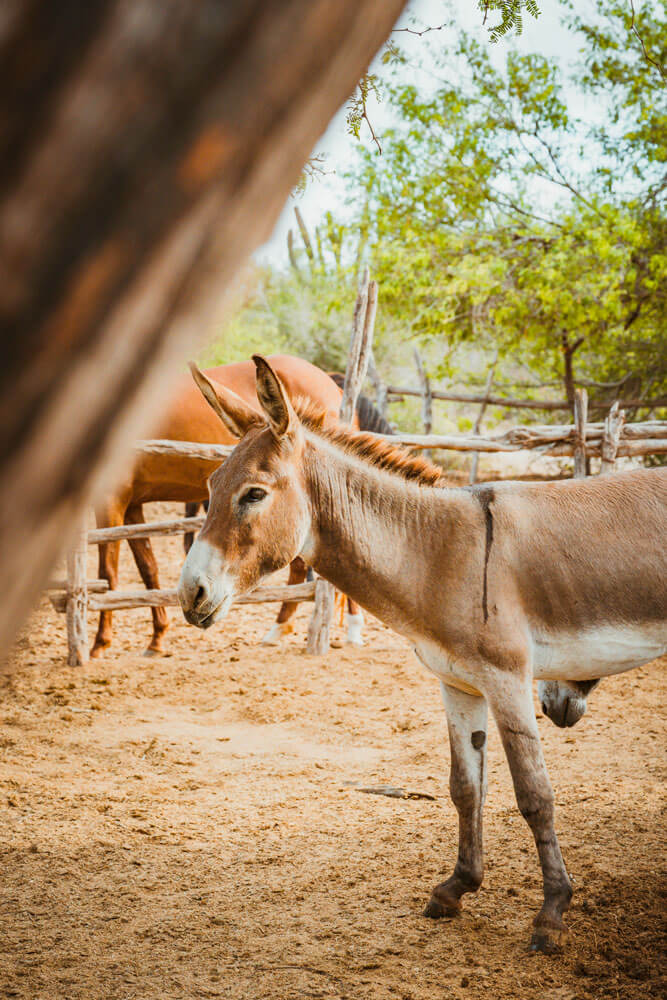No products in the cart.
No products in the cart.

Article updated on 12.20.22
Volunteering in a ranch in Baja
Since we started our trip, we always said to ourselves that we wanted to do volunteer work. It would allow us to experience the culture of the country in a different way than visiting it. We found the website workaway.info which lists places that offer volunteering all over the world.
So we created a profile and applied for several places. Rancho Carisuva agreed to let us stay at their ranch for a month.

Rancho Carisuva
This ranch is located in southern Baja, between Todos Santos and Cabo San Lucas. It offers tourists horseback riding, quad biking, donkey rides and the release of baby turtles.
The setting is incredible as the ranch is located between Migrino Beach and a cactus desert.






Our volunteering
The deal is that we work 4 hours a day for 5 days and in exchange we get food and a place to park our camper and the right to enjoy the horses and quads. The work is quite hard as we work outside in over 35 degrees but it is an incredible and unique experience.
We work as a team with employees and other volunteers. We take care of the morning shift and in our free time we can go for a ride on a horse or a quad if we want.





COUPON -5% :
ONVA
sur le Plan Santé AVANTURE
A typical day at the ranch
We wake up around 6.30am with Gala and Peluche (the ranch dogs who sleep under our camper) and feed them. Then we take a quad and put 5 bales of hay to feed the 32 horses and 12 donkeys. Finally, we feed the two pigs with cereals.
A little less glamorous, we clean the toilets for the tourists and the horse droppings in the ranch. The horses are free during the day. They wander between the ranch and the beach. If we leave their poop on the ground, the ranch is infested with flies that bother the animals.
At about 8 am we take a break to eat our breakfast to regain our strength. Then we prepare the horses for the tours with the tourists… We brush them and put their seals on.
Audrey welcomes the tourists and explains the history of the ranch and the safety rules. When the tourists come back from their tour, she makes them quesadillas and sells them beer and tequila.
Benji takes care of the tourists. He either takes pictures of the tourists during their horseback ride, or he is a guide for the ATV rides and takes the tourists for a ride through the dessert.
When the tourists are gone, the horses are released and normally we have finished our day. The rest of the afternoon we eat, rest and share good times with the other staff and volunteers.

Peluche that helps Benji to prepare the straw

Donkeys waiting for one thing... to eat!

Horse brushing

and sealing of the horses

or small treats for some of them

The view from the hill beside the ranch

Our friend and guide : Luis

Rattlesnake

Fortunately, Benji saw it in time

Us who imitate the cactus

The famous cactus

And the little snake

Benji and his friend

Audrey in afterwork



The turtles
One of the activities of the ranch is the protection of turtles. From September to December, the turtles come to the beach to give birth between sunset and sunrise.
A team patrols the beach all night to find the turtle nests. The aim is to recover the eggs and put them back in a closed enclosure, safe from predators. Indeed, turtles are endangered, only 3 babies out of 1000 reach adulthood. Their predators are humans (some like to eat the eggs in soups even though it is illegal), birds, worms and marine wildlife.
Here are the different steps to save the turtles:
From sunset to sunrise, patrol the beach on a quad bike. You have to identify the turtle tracks to find the nests. As soon as a track is found, you have to use a stick to probe the sand and find the eggs. Once the hole is found, dig with your hands until you see the eggs (about 50-60 cm deep). Then you have to count all the eggs by transferring them into a bag (between 80 and 150 eggs per nest), then you have to drive to the secure enclosure and dig a hole the same size as the one created by the mother turtle. Each egg must be placed carefully in the hole and then covered with sand. Finally, the various data (dates, number of eggs, area, etc.) must be written on a piece of wood that is placed on the nest. 30-40 days later, the baby turtles will hatch and be released into the ocean.
During the high season, there are between 1-30 turtles per night… it is a very hard and physical job. We are impressed to see these passionate people helping these turtles!
We had the chance to experience it for one evening and that was enough for us. We couldn’t have done this for a month, too exhausting for us 😅











COUPON -5% :
ONVA
sur le Plan Santé AVANTURE

Our colleagues who have become our friends <3. (Max, Sophie, Luis, Bea, Gala and Peluche)